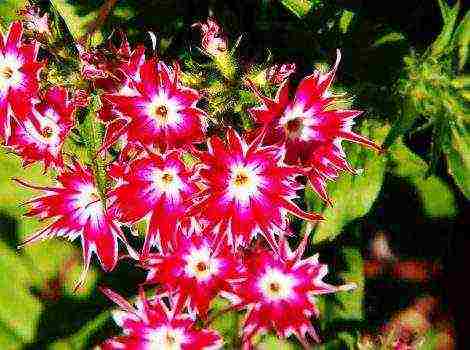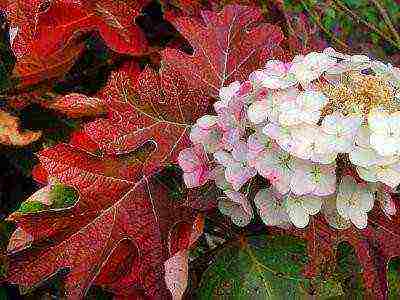Content
- 1 Choosing a place for a shrub
- 2 Landing features
- 3 The subtleties of dressing and watering
- 4 Preparation for winter and possible difficulties
- 5 The timing of planting lavender in the ground
- 6 Planting lavender seedlings in the ground
- 7 Planting lavender in the ground with cuttings, parts of a bush and layering
- 8 Taking care of lavender after planting outdoors
- 9 Description of the plant
- 10 Growing lavender
- 11 Planting lavender outdoors
- 12 How to care for lavender after planting outdoors
The delicate aroma of lavender, enchanting and unique, envelops itself, relaxing and calming, and as if transports to a magical land where worries and sorrows do not exist. But the planting of lavender in open ground is carried out by the owners of summer cottages not only for the sake of the magical smell of the plant. When its seemingly modest fluffy bushes are covered with bright lilac flowers, turning a modest border into a magnificent living carpet, it is impossible to look away from this beauty. Growing lavender in the garden will not be difficult, but caring for it will still require some skill.
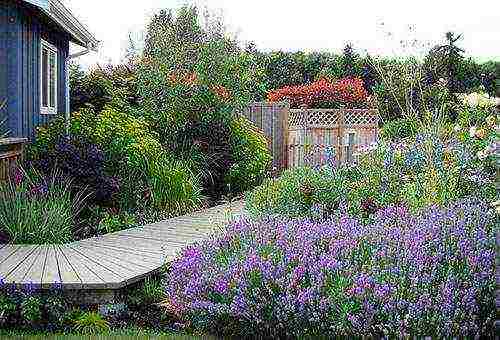
Choosing a place for a shrub
The basis for the full development of a plant in the open field, high decorativeness of its bushes, lush and long flowering is the correct planting. Lavender is photophilous, so it is better to place it in the country in open areas that receive the maximum amount of sunlight during the day. It can actively grow in the shade, but this will have a bad effect on its flowering. A warm climate is preferable for a shrub, it does not tolerate cold well. In the northern regions, it is better to plant it not in open ground, but in flowerpots, which are immediately removed into the heat when the temperature drops. All plant varieties are suitable for potting.
Excessive soil moisture is contraindicated for lavender; in such conditions, its roots quickly rot. Therefore, a future flowerbed or border should not be broken in areas with swampy soil or in damp lowlands. It is also important to take into account the level of occurrence of groundwater, they should not come close to the surface. If the soil in the place where the flowers are supposed to be planted does not meet the moisture requirements, good drainage will help to solve the problem.
The culture is demanding on the quality and structure of the soil. Preferred for her is a soil with a neutral reaction. To achieve it, the site on which it is planned to plant the plants is dug up, having previously sprinkled lime or wood ash over it. Providing proper care for lavender will be difficult if you don't stock up on compost in advance. It will give the soil the necessary lightness and looseness, as well as increase its fertility. The answer to this concern will be the luxurious flowering of the plant.
Much also depends on the biological characteristics of the selected variety. Broad-leaved lavender varieties are more hardy, so they will thrive in semi-shaded areas in the garden. They can also be planted in slightly acidic soil. Narrow-leaved plant varieties will require more complex care. They endure cold weather, but high soil moisture is destructive for them, and if they stay under a thick snow cover for a long time, lavender bushes can die from damping.
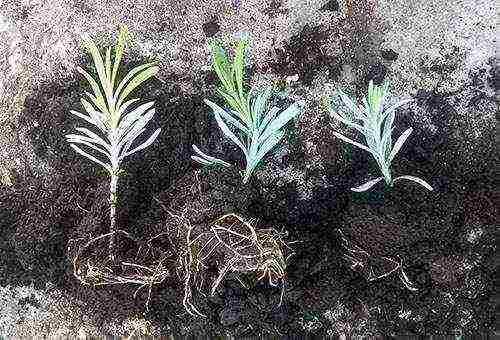
Landing features
It is not difficult to plant these mountain flowers. To do this, you can use:
- cuttings;
- layering;
- seeds;
- mother bush by dividing it.
Most often, planting lavender in open ground is carried out by seeds. They are sown into the soil in October, deepening 4 mm from its surface and slightly compacting the soil in the garden. If the autumn turned out to be dry, the procedure is completed with watering. In order for crops to survive the winter cold well, they are covered with a thick layer of snow.
Advice
In sealed containers, lavender seeds can be stored for many years without losing their high germination ability.
The successful cultivation of flowers in the garden is possible with spring sowing. But it will require preliminary preparation. In early spring, the seeds, mixed with wet sand, are placed in a refrigerator, where they are stored at a low temperature (best around + 5 ° C) for 2 months. After the completion of stratification, in May, they can be planted in the ground, using them to create an unusual flower bed or a luxurious border in the country. Seedlings will bloom only after 1–2 years, when their root system is sufficiently developed.
When choosing a place for a flower bed, it is worth considering that adult plants often do not take root during transplantation. If it is still necessary, then the procedure must be carried out carefully, making sure that the roots are in a voluminous lump of soil. To make lavender bushes lush, they are rarely placed on a flower bed, at a distance equal to the maximum height. In curb landings, this interval is halved. Then the hedge will turn out slender and give the impression of solidity.
It is even easier to propagate the plant with cuttings that root quickly and easily. They are placed in loose soil, covered with a film, after which it remains only to provide future seedlings with regular soil moisture. It is not necessary to deepen the cuttings, a distance of 1-2 cm from the surface is enough. After rooting, they are carefully dug up and placed on the prepared area.
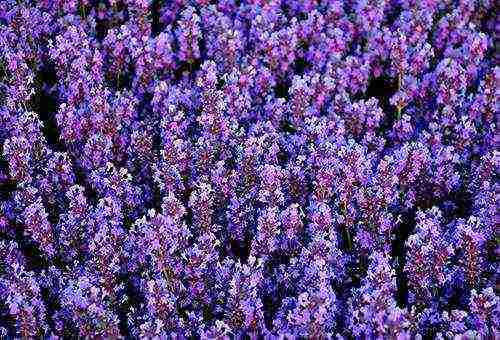
The subtleties of dressing and watering
Caring for lavender in the open field provides for several activities that will have to be carried out alternately throughout the growing season. Plants need to be fed regularly. It is better to use fertilizers with a high potassium and low nitrogen content for this. It is not worth using manure to enrich the soil: an excess of nitrogen in the soil is fraught with the fact that lavender bushes will actively branch, delighting with dense juicy greens, but they form few buds.
Watering should be done in moderation. The plant does not like excess moisture, but it also does not tolerate its lack, responding to it with meager flowering. It is worth starting watering lavender in the garden only when the topsoil in the garden dries well.
High hilling and mulching of the beds will help to keep the moisture necessary for plants in the soil, as well as to increase its porosity. Both procedures are carried out regularly - in the spring and autumn. They also increase the decorative effect of lavender bushes, influencing the formation of young shoots on their trunks. Decayed foliage works well for mulching. You can also purchase special multi-colored substrates in the store, which will make the beds even more attractive. The procedure will require attention. To prevent rotting of the flower, the soil at the base of its trunk is left uncovered.
Caring for a plant in the open field involves its systematic pruning. It increases the lifespan of lavender bushes. It is carried out twice: after the end of flowering and towards the end of the growing season. When the buds of the plant wither, it is enough to shorten the stems on which they were located by 1-2 cm. Autumn care is more intense, it involves the removal of most of the old shoots from the bush. No more than 4-5 young stems are left on it.
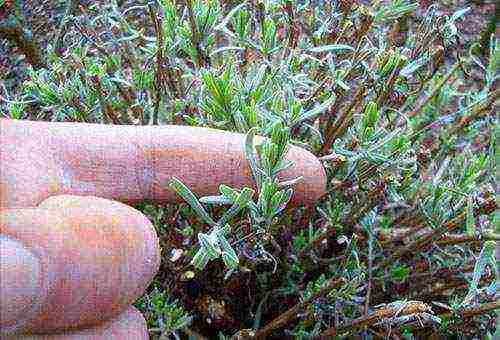
Preparation for winter and possible difficulties
Growing lavender successfully in areas with harsh winters, where the temperature drops to -25 ° C, is possible, but for this it will need to be reliably insulated. After cutting flowers on the eve of the first frost, they should be tightly covered with spruce branches.It will help the plant survive a difficult period for it.
Advice
Dry foliage cannot be used to shelter lavender bushes. Due to the high moisture content of the soil under it, rot can affect them. The likelihood of damping out is also high in such conditions.
For lavender care in the garden to be complete, it is important to arm yourself with the knowledge of the possible problems that growing a shrub can bring. The greatest danger for him is gray rot. To prevent its rapid spread and the death of plantings, regular inspection of the flower bed will help to remove and immediately burn the infected areas of the plant.
Gray rot creates favorable conditions for the reproduction of the penny, in which it lays its larvae. On lavender bushes, an ugly white foam appears that looks like saliva and protects the insect's offspring from predators. It does not harm them, but spoils the decorativeness of the plantings. It is not difficult to remove it from the plants; it is enough to wash off the formation with a water jet.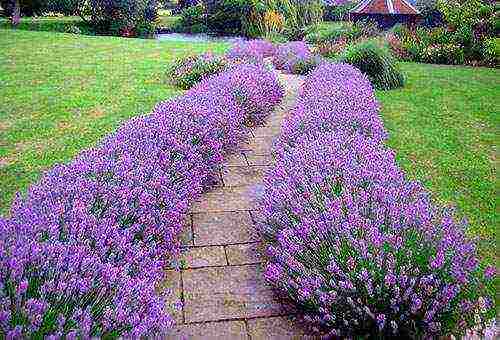
Planting lavender in a summer cottage is a beneficial solution from all sides. Its single bushes will become an elegant decoration of a flower bed or garden, and numerous ones will form a lush curb from which it will be impossible to take your eyes off. During their long flowering, they will fill the air with a delicate, mesmerizing aroma. The cultivation of this mountain shrub is also practical: dangerous garden pests - the Colorado potato beetle and the moth - do not tolerate its smell. Just plant the plants between root crops and you don't have to worry about the safety of the crop.
Caring for lavender is not difficult, but you still have to devote time to it. Choosing the right site for planting, competent watering and feeding, mulching and hilling the beds, pruning - performing these simple procedures will allow you to achieve the desired result.
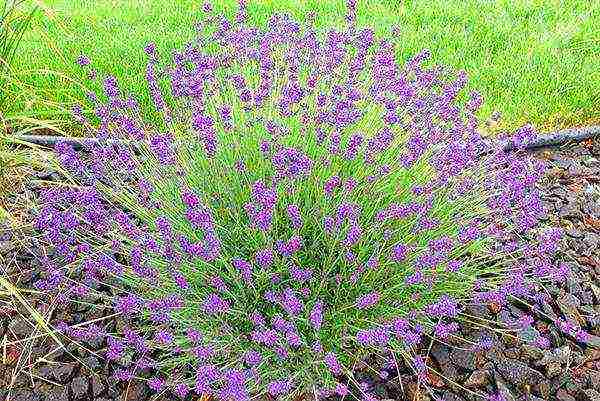 In the numerous family of Yasnotkovs, there are a lot of plants that have amazing decorativeness, an extraordinary aroma, and other useful properties. If the summer resident wants his site to be decorated with lavender, planting and care in the open field is a key moment on the path to success.
In the numerous family of Yasnotkovs, there are a lot of plants that have amazing decorativeness, an extraordinary aroma, and other useful properties. If the summer resident wants his site to be decorated with lavender, planting and care in the open field is a key moment on the path to success.
A perennial essential oil crop up to 60 cm high with spike-shaped blue or purple inflorescences has become a symbol of Provence. Lavender is grown in the Mediterranean, and in Russia it is planted in the Crimea and the Black Sea coast of the Caucasus.
Can a thermophilic plant take root in the middle lane? How to tame the culture of a gardener in Siberia or the Urals?
Among the plants related to lavender, there are many that, as a result of growing on personal plots, have completely assimilated, becoming part of the native flora. And some of them are well-known wild plants. These are motherwort and oregano, thyme and mint, catnip and lofant.
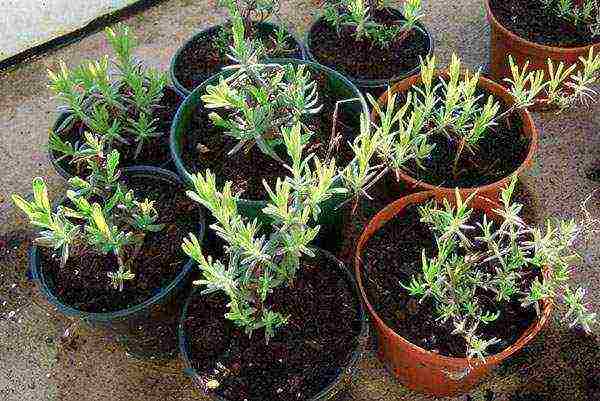 For the southern heat-loving beauty, the climatic conditions of our country are far from always comfortable. Still, planting lavender in the ground is possible. The main thing is to choose the right place, time and follow the rules of care.
For the southern heat-loving beauty, the climatic conditions of our country are far from always comfortable. Still, planting lavender in the ground is possible. The main thing is to choose the right place, time and follow the rules of care.
The timing of planting lavender in the ground
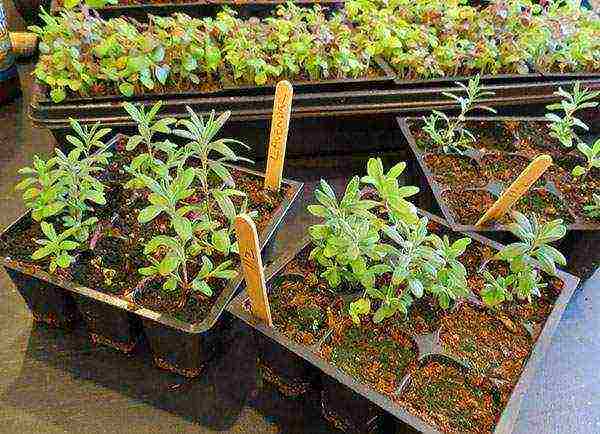
Of all the varieties of lavender, Lavandula angustifolia or narrow-leaved lavender is recognized as the most frost-resistant and unpretentious.
Under cover, it can survive frosts down to -35 ° C, which is quite comparable with winter temperatures not only in the central part of the country, but even in the Urals or Siberia.
Lavender is propagated by seeds and vegetatively using parts of an adult bush, rooted cuttings or cuttings.
In the first case, like many other decorative perennials:
- at home, medium-sized seeds are sown for seedlings in early spring;
- when stable heat comes, you can sow seeds in the beds;
- planting lavender in the ground in the fall is carried out to obtain plants for next year.
Vegetative reproduction helps to bring flowering closer. In this case, seedlings with their own root system fall into the soil in the second half of summer or autumn.Specific dates directly depend on climatic and weather conditions.
In the middle lane, planting and caring for lavender in open ground is subject to the rules common to all regions. The seeds should fall into the warmed-up soil when the sprouts are not threatened by spring frosts. And before that, in order to accelerate germination, they are stratified in a refrigerator.
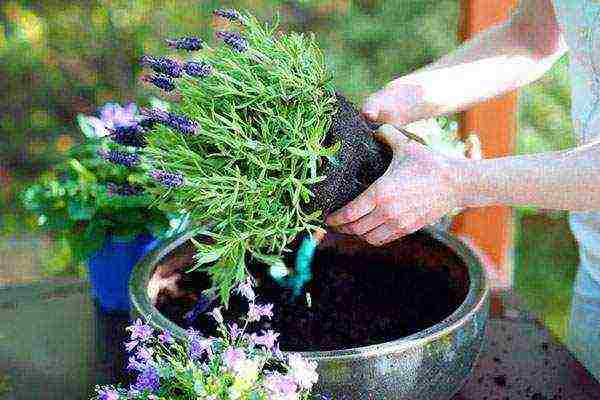 In the central part of Russia, such conditions for sowing develop by the second half of May. In the regions to the north and east, the soil warms up even later. Unfortunately our summer is short for lavender. Seedlings very often die without surviving the winter. Therefore, planting lavender in open ground in the Urals, for example, is preferable to seedlings obtained as a result of winter or early spring sowing, or seedlings obtained from an adult bush.
In the central part of Russia, such conditions for sowing develop by the second half of May. In the regions to the north and east, the soil warms up even later. Unfortunately our summer is short for lavender. Seedlings very often die without surviving the winter. Therefore, planting lavender in open ground in the Urals, for example, is preferable to seedlings obtained as a result of winter or early spring sowing, or seedlings obtained from an adult bush.
Planting lavender seedlings in the ground
 At the end of February or in March, when the period of stratification ends, seeds are sown on the surface of a mixture of fertile garden soil and sand. It is useful to pre-sterilize the substrate and sort out large inclusions.
At the end of February or in March, when the period of stratification ends, seeds are sown on the surface of a mixture of fertile garden soil and sand. It is useful to pre-sterilize the substrate and sort out large inclusions.
The crops are sprinkled with a thin layer of sand and placed in a home greenhouse. Germination takes place in the light at a temperature of 17–22 ° C. To maintain moisture, the soil is periodically sprayed with warm water, and to avoid the appearance of mold, the container is ventilated. The first shoots should be a signal that the plants need additional lighting. When the seedlings get stronger, they are dived, seated at a distance of 5 centimeters.
It is convenient to use peat pots before planting lavender in the ground. In them, the plants develop well, their roots are protected from decay and do not suffer during transfer to the garden.
 At the end of May, it is time for planting in the ground and caring for lavender in the Moscow region. For plants, choose dry, ventilated and well-lit places, the soil on which has a pH level of no higher than 6.5-7.5. The site is dug on a bayonet, simultaneously bringing in peat, humus and, if necessary, dolomite flour, loosening the ground.
At the end of May, it is time for planting in the ground and caring for lavender in the Moscow region. For plants, choose dry, ventilated and well-lit places, the soil on which has a pH level of no higher than 6.5-7.5. The site is dug on a bayonet, simultaneously bringing in peat, humus and, if necessary, dolomite flour, loosening the ground.
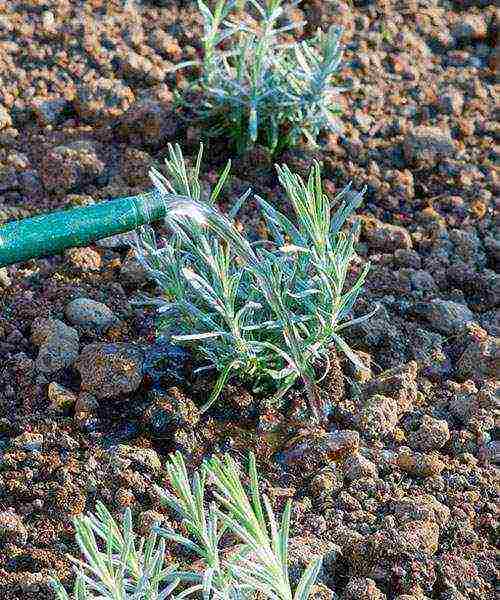 Seedlings are carefully transplanted, leaving at least 70-90 cm of free space between the plants, it will definitely come in handy for the growing bushes. During planting, the tillering point is slightly deepened, then the soil is compacted and thoroughly shed.
Seedlings are carefully transplanted, leaving at least 70-90 cm of free space between the plants, it will definitely come in handy for the growing bushes. During planting, the tillering point is slightly deepened, then the soil is compacted and thoroughly shed.
Autumn sowing of lavender is practiced only in the southern regions, where the seeds do not freeze, and immature sprouts can, without fear of spring cold, immediately grow. After planting the seeds in the ground, the beds are watered, and with the first frost they are abundantly covered with snow.
Planting lavender in the ground with cuttings, parts of a bush and layering
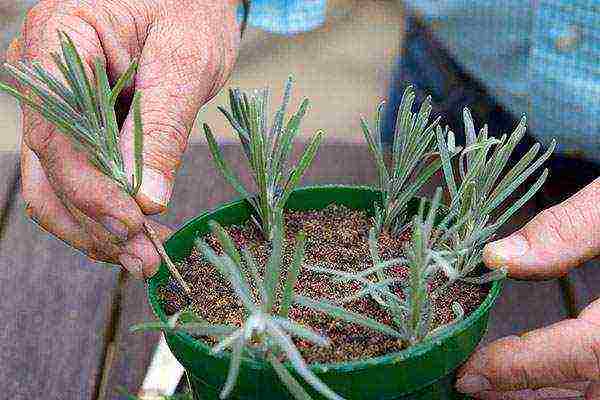 If there is an adult plant on the site, you can:
If there is an adult plant on the site, you can:
- divide it, getting seedlings with growth points and a root system;
- get cuttings that, after rooting, are easy to plant in the ground;
- create conditions for the formation of stem layering.
The lavender bush intended for dividing is carefully spud before wintering, and the shoots are cut off at a height of 10 centimeters. In spring, hilling is repeated, stimulating the formation of young shoots. A bush prepared in this way is dug up in the fall and divided into independent parts. Lavender is immediately planted in the ground, in the fall the plant has time to acclimatize and prepare for winter.
In spring and summer, lavender shoots are used for cuttings. 8–10 cm pieces of stems are planted in wet sand, deepening by 2–3 cm. In a greenhouse, cuttings form roots over the summer. With further home care for lavender, planting it in open ground is carried out in May or early June.
To obtain layering, selected strong shoots in the spring are tilted to the ground and buried in, fixing with a metal hairpin at a depth of several centimeters.
During the summer, the cuttings are looked after by weeding the soil nearby and watering the root formation sites. In the fall, such seedlings are separated from the mother bush and planted in a permanent place in the garden.
Taking care of lavender after planting outdoors
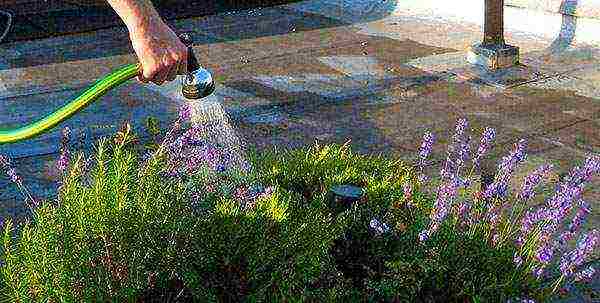 Lavender is planted for its fragrant blue-purple flowers.But on young plants in the first year of life, all the buds are cut off without waiting for flowering. This will strengthen the open field planting of lavender and make it easier and more effective to care for them. Throughout the life of the bushes, they must be weeded and watered.
Lavender is planted for its fragrant blue-purple flowers.But on young plants in the first year of life, all the buds are cut off without waiting for flowering. This will strengthen the open field planting of lavender and make it easier and more effective to care for them. Throughout the life of the bushes, they must be weeded and watered.
Lavender is a hardy crop, but it needs moisture to bloom. In hot weather, watering should be abundant and frequent.
Adult bushes form a dense dense cushion on the surface of the soil, so it is problematic to loosen the soil under them, but it is very important to keep the area around them clean. A layer of peat mulch will help to save moisture and airiness of the soil.
Spring-autumn hilling helps to maintain the density of the crown. It stimulates the formation of young shoots, gradually replacing aging branches. Pruning plants serves the same purpose. It is carried out after flowering and during it. For bushes aged 7-10 years, rejuvenating pruning is recommended, during which all shoots are shortened to 5 cm in length.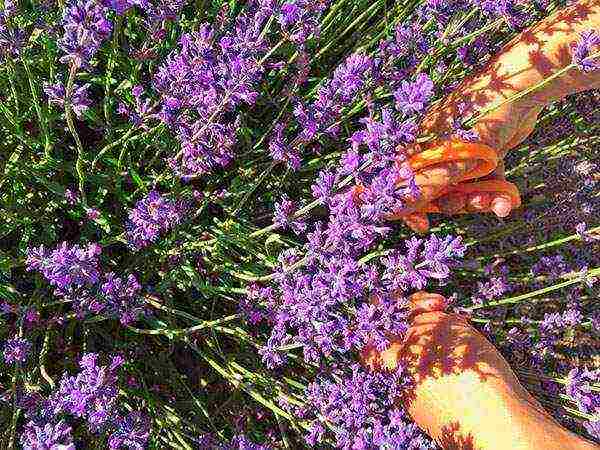
To fertilize lavender, mixtures with a predominance of potassium are used, which stimulates the formation of buds. Nitrogen is applied in moderation in the spring.
Southern crops, including lavender in Russian conditions, are at risk of freezing. To prevent this from happening, the bushes before frost are covered with spruce branches, non-woven material or other breathable types of protection that allow air to pass through, and then sprinkled with abundant snow.
Video about amazing lavender

A very pleasant smell came from the neighboring front garden, it turned out that the neighbor was growing lavender, planting and caring for it in the open field, as I found out, couldn't be easier. So I also got the idea to plant this plant in my home.
This dwarf shrub of the family is a relative of thyme, mint, rosemary. It mainly grows near the Mediterranean Sea, there are about 28 types of lavender. Many are used in the perfumery industry, for the manufacture of perfumes, soaps, and toilet water.
Content
- 1 Plant description
- 1.1 Varieties of lavender
- 2 Growing lavender
- 2.1 Landing
- 2.1.1 Landing site
- 2.1.2 Landing features
- 2.1.3 Lavender propagation methods
- 2.1.4 Sowing lavender seeds
- 2.2 Caring for lavender
- 2.2.1 Watering
- 2.2.2 Loosening
- 2.2.3 Fertilizing and feeding lavender
- 2.2.4 Pruning lavender
- 2.2.5 Diseases and pests
- 2.2.6 Preparing for winter
- 2.3 Combination with other plants
- 2.4 Application of lavender
- 2.4.1 How to grow lavender from seeds, video
- 2.1 Landing
Description of the plant
A half-shrub about a meter high, of a greenish-steel color, looks very decorative. Narrow leaves, up to 5 cm long, are covered with silvery hairs. Purple flowers are collected in terminal inflorescences, blooms from late June to mid-August.
Even when dried and processed, the plant retains its divine aroma. If you keep a sprig of lavender in the closet, the linen will acquire a long-lasting pleasant smell. No wonder the French are interested in this plant. After all, what kind of products is there with the scent of lavender. All famous perfumery companies use essential oils for the fragrances of various creams, gels, scrubs.
Varieties of lavender
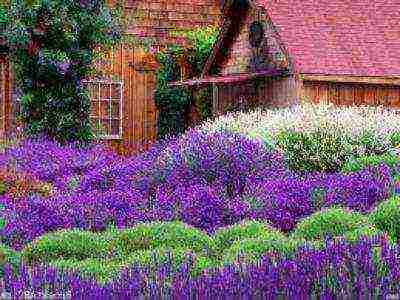
There are a little more than 25 types of lavender in nature, but we grow only a few species in our gardens.
English lavender (narrow-leaved) is an unpretentious variety with a compact bush no more than a meter in diameter. Leaves are gray-green, narrow, elongated. The flowering period is from June to July. The variety is frost-resistant. French lavender (broadleaf) - all varieties that are grown in our gardens have gone from it. A distinctive feature, a light range of leaves and flowers. Has a very strong, sometimes unpleasant odor. Dutch lavender (hybrid) is a direct descendant of narrow-leaved and broad-leaved. The largest representative of the genus, the bushes grow up to 2 meters. More often grown for industrial purposes. Serrated lavender is thermophilic and delicate. Prefers indoor growing.It is famous for its appearance with silvery petals and purple inflorescences.
Growing lavender
Remember the popular lavender song? A mountain flower means it does not like wet soils with stagnant waters. The roots of the plant grow very widely, which allows it to extract moisture on its own. The plant loves well-drained soil and sun.
Landing
Pick-up location
It is very important for this plant to choose the right place. Open, sunny areas on the hills are exactly what lavender needs. In the shade, of course, it can also grow, only the flowering will not be so abundant and lush.
In addition, it must be borne in mind that the roots of the plant react negatively to waterlogging. It is unacceptable for her to plant in places with stagnant water and swampy areas. If you do not have a suitable planting site, do not be too lazy to make a mound and plant lavender there.
Lavender also has requirements for the composition of the soil, they may not be followed, but then, again, you will lose the privilege of enjoying the full splendor of flowering.
Soils should be chosen not acidified or deoxidized in advance with lime or dolomite flour. As a fertilizer, the plant loves making compost, which will make the soil fertile and loose.
Landing features
The plant is most often planted along curbs or paths. To make the bushes look more magnificent, the distance between them should be equal to the height of the variety that you are going to plant. It should also be taken into account that adult lavender plants do not tolerate transplanting very well, so dig them up and transfer them with a large clod of earth. If it is not possible to dig out already mature bushes, you can choose an alternative planting method.
Breeding methods for lavender
- By dividing the bush, you can propagate it when you already have adult plants. To do this, in the spring, the mother bush is sprinkled with earth so that all the layers are separated. In the fall, they can be trimmed and seated in other places.
- It is very simple and quick to propagate lavender by cuttings. It is enough in the spring to cut cuttings about 10 cm long from lignified shoots and plant them in a loose and moist soil in a greenhouse. Water and ventilate them constantly. In the fall, cuttings with roots can already be planted in permanent places.
- Layering is also quite easy to propagate lavender. In the spring, bend the shoot, bend it and sprinkle it with soil at the point of contact. By the fall, roots grow there, now it can be neatly separated, processed a cut and planted in another place.
- To propagate lavender by seeds is within the power of a gardener with experience. If you sow them in the spring, then in advance, two months in advance, you need to place them in wet sand and keep them in the refrigerator all the time. They may not emerge without stratification. In autumn, you can also sow seeds in open ground, in winter, throw more snow on this place, but it is possible that the seeds will not freeze in northern latitudes.
Sowing lavender seeds
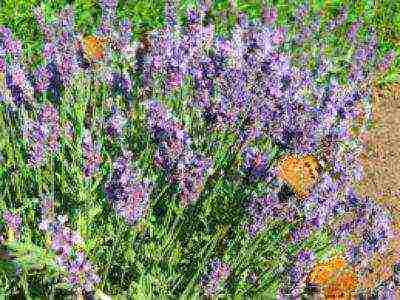
When properly stored, lavender seeds are capable of germinating for a very long time. Choose the time as it is more convenient for you to sow them. If you do this in the spring, in May, then place the seeds in wet sand in advance, pack them in a plastic bag and put them in the refrigerator for two months. You need to store at a temperature of + 2-4 degrees. You can dig seeds in a greenhouse in early spring, covering them with snow.
In autumn, in October, seeds are immediately sown in open ground, compacting the soil and watering well. Again, this is more suitable for gardeners in the Moscow region, where the climate is milder than in the middle lane.
Lavender care
Watering
Water the lavender as little as possible. Check when the soil under the bush is completely dry. If you notice that the shoots have begun to turn yellow, this is a signal that the soil is overly moist and the roots begin to rot.
Loosening
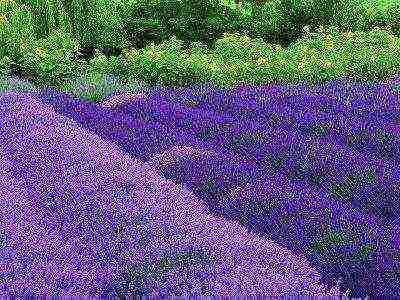
Perhaps this is the most important thing in lavender care, because its roots do not tolerate soil compaction, they need to breathe, so the plants grow and develop better.you need to loosen constantly, especially after each watering and rain.
To make it easier for yourself to free up time, you can mulch the soil around the bushes with humus or peat. It will also be a fertilizer.
Fertilizing and feeding lavender
In general, the plant does not need much feeding, especially if the soil is fertile. Nevertheless, to prolong the abundant flowering and ensure the growth of the plant, apply top dressing.
In the spring, nitrogen-containing fertilizers are applied once a month. They are necessary for building up green mass. But they are introduced only during the period of active growth, then we cancel them and switch to complex mineral fertilizers. They are used throughout the entire flowering period.
If you use compost or rotted humus as mulch, then you can do without additional fertilizing, the plants will take all the necessary substances from the soil.
Pruning lavender
If you notice a stop in the growth of a lavender bush, then it must be transplanted to a new place.
In general, pruning lavender bushes is not necessary unless you want round, fluffy bushes. They are cut in two stages:
After the inflorescences wither. In the fall, before preparing for winter.
You only need to trim by two centimeters, no more. When carrying out autumn pruning, do not get carried away, if you cut the bush too short, it may die.
Diseases and pests
Probably due to the high content of essential oils, the plant is not very susceptible to attacks by pests, and diseases are rare, especially with good care.
Of the diseases, the most common gray rot is due to improper watering. The disease cannot be treated, it is extremely important to notice it in time and remove diseased plants. They are taken out of the garden and burned.
Of the pests, you can find the rainbow beetle. But it is found in such small quantities that it is easy to pick it up by hand.
Preparing for winter

Lavender can easily withstand freezing temperatures down to -25 degrees. But still, in the middle lane, it is better to make shelters for it.
Do not cover the lavender bushes with fallen leaves for the winter, the plant will begin to flirt and may die.
The best shelter for shrubs, branches of conifers. The foil allows air to pass through well, circulating inside the shelter, and retains snow well.
In places with a mild climate, lavender is usually not covered with anything; it winters well without freezing.
Combination with other plants
Lavender can often be found along hedges, curbs, paths. It is planted in a composition with roses, they have a good aroma. Blue lavender flowers contrast well with orange or red flowers.
You can grow lavender next to hydrangea. It will look elegantly on an alpine slide among spicy herbs. Combines with sage and gypsophila.
Small varieties of lavender will look good in a planter on the terrace. Or you can experiment and plant a large piece of land with shrubs, you get an incredibly fragrant carpet of purple-blue flowers.
Application of lavender
The plant can be used to flavor tea, cold drinks, add to fish and meat soups, vegetable dishes. Lavender goes especially well with lamb.
Thanks to its essential oils, the plant has become widespread in medicine. It helps well with insomnia, nervous excitement and fatigue.
A fragrant lavender dwarf shrub, planting and caring for which is not very difficult, will adorn any garden. And its essential oils can be used in homemade soap making.
How to grow lavender from seeds, video

Lavender is a unique plant that is widely used in cosmetology, medicine, for decorating an interior or a summer cottage. In order to grow lavender, you need to know how to properly plant and care for it outdoors. This also applies to gardeners who live not only in the northern regions of Russia, but also in the middle lane.With your own hands, you can grow beautiful lavender bushes if you follow the tips and tricks from this article.
Planting lavender outdoors
At the moment, there are about 25 types of lavender, each of which has a unique aroma, color and shape of the leaves. Before planting lavender, study the varieties available, because some of them are frost-hardy, while others are ideal for the climate in the middle lane. So serrated lavender is considered one of the most thermophilic varieties, and English lavender is quite resistant to frost.
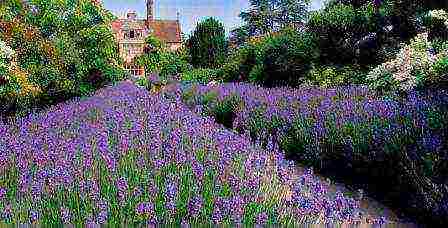
Mixborders from lavender in the country
Also Read: Beading, Beaded Lavender
You can breed lavender in different ways:
- Sowing seeds
- Dividing the bush
- Cuttings
- Layers
The hardest part is to start growing lavender with seeds, as certain conditions must be met. Find a suitable box, fill it with sandy soil, and then sow the seeds. The box must be placed in a room with an air temperature of up to +5 degrees, so the best option is to grow lavender in the winter. The seeds should stand in the cold for a month, and then the box can be taken out into a warm room until the first shoots appear. In open ground, seedlings are planted in May, when the threat of frost has passed.
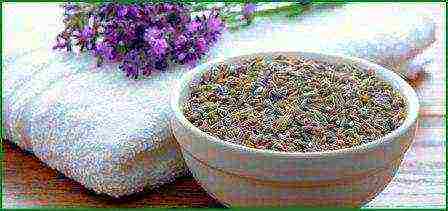
Growing lavender from seeds
It is less troublesome to grow lavender by cuttings, dividing a bush or layering, but these methods are relevant when you already have lavender bushes in the country or you can buy them from someone.
It is also important to choose a suitable place, because this plant loves the sun and sandy soil. Do not plant lavender bushes near rivers and ponds. It is possible to grow lavender in pots at home, but you will have to monitor the temperature and moisture to keep the flower comfortable.
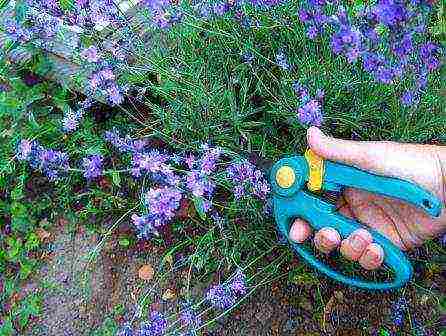
How to care for lavender after planting outdoors
Lavender does not like excess moisture, so there is no need to water it abundantly in the country. Limit the amount of watering to once a week, and in cooler seasons, to once every two weeks. It is not necessary to fertilize lavender bushes with nitrogen and organic means, it is better to apply potassium fertilizer. Many gardeners feed lavender exclusively with compost mulch, therefore, their plant is actively growing. You can decide for yourself how you will feed the flowers on your own plot.

Pay attention to the growth and development of bushes in the open field, if lavender does not grow, then the place is not suitable for it. Transplant the lavender bushes to a new location. It is advisable to transplant in the fall before the onset of cold weather or in the spring.

Growing lavender in pots at home
Lavender will not only decorate the landscape design, but also the interior of a country house. You can use the dried flowers to keep moths at bay or for decoration.
Knowing conditions for planting and caring for lavender in the open field, you can plant this flower in your own flower bed. Lavender is often used for mixborders and flower beds that bloom all summer. With your own hands, you can breed this fragrant flower in your own dacha.
